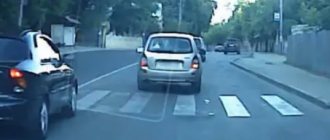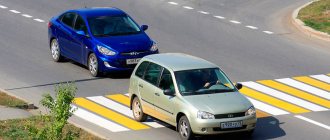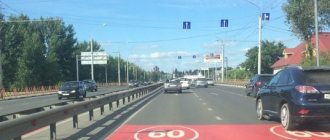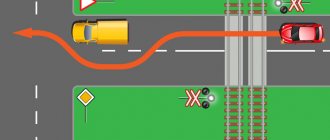In what cases and in what amount is a fine imposed on a motorist for a pedestrian? Road traffic involves two types of participants on the roadway - various vehicles and pedestrians. However, both of them, in order not to interfere with each other, must move according to certain rules. The legislation strictly monitors violators and provides for a fine for a pedestrian if a car does not allow him to cross the zebra crossing. However, the pedestrian is also punished if an accident occurs due to his fault.
Fine amount in 2021
By obstructing a person when he crosses the street at a zebra crossing, the driver may receive an administrative penalty. This is stipulated by current legislation. The fine for a driver who fails to let a pedestrian pass, depending on the specific circumstances of the case, can be 1,500–2,500 rubles.
Confirmation of the driver’s misconduct can be a recording of a traffic camera or an interview with witnesses. If the offense was recorded by a “safe city” camera or video recording from a police car, then it will be very difficult to prove your innocence.
Therefore, it is important to know in what cases you can receive a punishment.
Penalties are imposed on the driver in the following situations:
- when starting to move to a traffic light sign, when the pedestrian did not have time to completely cross the striped area;
- crossing a stop strip;
- obstructing the crossing of a blind pedestrian who signaled with a white stick;
- impossibility for passengers to board or exit public transport;
- obstructing a pedestrian when turning a car to the right;
- failure by the driver to recognize the priority of a pedestrian in a residential area.
Such incidents result in administrative liability for the driver. If a driver overtakes on lined lanes, the law provides for tougher penalties. This violation of traffic regulations is punishable by a fine of 5 thousand rubles or confiscation of the driver’s license for six months.
The fine for stopping at a zebra crossing has been in effect for several years now, and in 2018 it remains at the same level. Such a violation will cost the car owner 1,000 rubles, but this figure is not common in all regions of the country. The same violation in Moscow or the Northern capital of Russia raises the price of punishment exactly three times.
Didn't let a pedestrian pass - what a fine
An administrative fine for failure to pass at a pedestrian crossing can vary between 1.5-2.5 thousand rubles. The penalty is provided for by the Code of Administrative Offences, Art. 12.18 and is appointed at the discretion of the state traffic inspector. If the fact of non-passage is recorded by the camera, then the maximum amount of the penalty is assigned.
The driver can reduce the cost of the fine if he pays it within 20 days. In this case, he is given a 50% discount. The period is counted from the date of drawing up the resolution.
Video on the topic:
The concept of “pedestrian crossing” in the new edition of the traffic rules
A pedestrian crossing is a section of the roadway that is intended for the movement of people across the roadway.
Such areas are indicated by “Road Crossing” road signs or special striped markings. Joint markings are often used to improve the marking of a given area. Signs provide an opportunity for a person to maneuver to the other side of the street without interfering with traffic, and vice versa.
This index comes in two varieties:
- The pedestrian moves from right to left.
- He also moves from left to right.
A driver who fails to yield to a pedestrian is subject to a monetary penalty. Of course, traffic rules severely punish careless drivers, and the law is often on the side of others. However, video recording of the violation will allow you to appeal the punishment to the courts. You just need to understand what modern transitions look like and their characteristics. This will allow us to look at this offense a little differently.
Pedestrian sections for crossing the roadway have the following types:
- underground;
- overhead crossings;
- regulated by traffic lights;
- unregulated intersections.
Of course, the first two types do not cause any problems for participants in the road process - the sections bypass the roadbed from below and from above. A highway or intersection controlled by traffic lights is more dangerous to cross than the above settings. But if traffic rules are followed by both cars and people, there will be no danger. Even if you accidentally cross a red traffic light, the driver must use every opportunity to prevent a collision with a person.
The most dangerous crossings are unregulated crossings. However, the new traffic regulations state that crossing should not force a person to change their direction or speed. In other words, the pedestrian should not return to the sidewalk if he has already stepped on the zebra crossing. This case obliges the driver to give priority to the pedestrian. It goes without saying that an area with a non-working traffic light is automatically equated to an unregulated one.
In order not to commit an offense, the car must stop in front of the zebra crossing even before the moment when the person puts his foot on it.
It is allowed to continue driving only after reaching the other side of the street. Financial liability is provided for those who like to overtake in an area intended for the passage of people. This penalty appeared last year and provides for a fine, even if the transitional “bar code” is clear of pedestrians.
The legislation guarantees a person a free transition also in the following situations:
- The transition occurs when a vehicle comes around the bend.
- People are crossing the road in the adjacent area when a car drives into it.
- A similar situation, but with a car leaving.
- If a person is holding a white cane, that means he is “blind.”
- When people move to a public transport stop or return to the sidewalk.
Of course, the easiest way for a traffic police officer to put a driver in an awkward position is in an area where there are markings. However, this does not mean that every incident of not allowing a person to pass may result in a fine.
Perhaps there will be good reasons that will confirm the driver’s innocence. But repeated commission of an offense is punishable more severely than the fine above.
Can a motorist challenge the penalty?
If the violation is recorded on camera and traffic police officers have “iron proof” of the unlawful action, you shouldn’t even think about how to prove your innocence if you didn’t let a pedestrian pass - nothing will work out, it’s better to pay right away.
If there is no evidence, you can fight. The driver is recommended to act as follows:
- Ask the inspector to draw up a report. Under no circumstances should you transfer money to a traffic police inspector without a protocol.
- Catch up with a pedestrian and invite him as a witness.
- Check with him whether any obstacles have been created to prevent his movement. We remember when it is considered that the driver did not let the pedestrian pass - if the latter had to change the direction of movement (that is, retreat). Most likely, the witness will answer the question negatively - this way he will save his time.
- Explain to the pedestrian that he also did not follow the crossing rules (for example, he jumped at a zebra crossing). This must be done if the invited citizen, on the contrary, only confirms that he was indeed inconvenienced. In case of both traffic violations, a fine is issued to both the motorist and the person crossing the road.
If the inspector insists that there is no point in bringing a witness, the motorist should draw up a petition and indicate in it that there is no evidence of a violation and it is impossible to clarify the circumstances of the case.
Driver's dream - hit 2021!
- DVR with radar detector and GPS informer.
- Notification of distance reduction and lane change. Antisleep function.
- Stay safe on the road with the Roadgid X7 Hybrid GT. Watch the video!
TODAY'S PROMOTION find out more>>>
Review of a popular gadget among car owners
Read more>>>
If you have a Roadgid DVR in your car, a citizen will be able to easily and quickly prove his innocence (unless, of course, he really committed a violation).
A complaint about unlawful actions of a traffic police officer can be filed within 10 days from the date of the “violation.” The complaint is drawn up in free form, so there is no need to involve lawyers to write it. The main thing is to provide evidence of innocence (for example, video from the Roadgid recorder). The complaint should indicate the full name of the traffic police officer who recorded the “violation,” as well as the fact that the officer refused to involve a witness. The complaint is submitted to the traffic police department.
Please note: the driver is not present during the consideration of the complaint, which means he cannot present arguments in his favor. That is why the “dubious” decisions of traffic police inspectors remain in force.
If a complaint is answered negatively, this is not a reason to give up. The driver can prove that he knows how to correctly let a pedestrian pass at a pedestrian crossing in court, but he should only come to court with complete confidence that he is right.
Mandatory passage for blind pedestrians
It is the driver’s sacred duty to let a blind person pass on any section of the road, even in the absence of striped markings. Failure to comply with this rule threatens the person driving with an administrative fine of one thousand rubles.
The main attribute of a blind person when crossing the road appears to be a white cane, equated to the prohibitory gesture of a policeman. Lack of vision does not always allow a disabled person to accurately determine the location of the crossing, so he may step onto the roadway in a place not intended for this purpose. Therefore, the driver must give way to a person with a white cane, regardless of the choice of that passage.
Myopic people do not belong to this category, but if a pedestrian looks at the windshield of a vehicle, this does not mean that he sees the car and will make it to the parallel side. He may not be a sprinter, or may have a slow reaction, which will lead to a collision with a person. Please remember that people may be under the influence of alcohol or drugs.
Not every person who takes dark glasses and a white stick is considered blind. By the way, scammers sometimes use such attributes. Therefore, having hit or failed to give way to such a “blind” person, and having been subject to penalties, the alleged violator has the right to demand a medical examination of the victim.
If the victim really showed signs of illness, you should make sure that he had a white stick with which he signaled the car.
We allow pedestrians to enter and exit the adjacent territory
The article of the traffic regulations reminds that when a vehicle leaves an adjacent area onto the road, the driver must give way to other vehicles and people walking along it. When turning off the road, give way to cyclists and pedestrians, whom he may interfere with.
Adjacent areas are designated:
- house yards,
- residential areas,
- gas stations,
- various types of parking,
- territories of objects that are not intended for through passage.
The traffic rules also stipulate the rules for turning towards the adjacent territory. Before performing the maneuver, the car must take the extreme position of the road surface. This means that the car should be almost at the very edge of the sidewalk. Failure to follow the recommendation may provoke a cyclist or motorcyclist to wedge into the resulting gap without the driver noticing. However, if the latter is noticeable, the driver will have to let him go ahead without starting the turn.
Turning left and passing through a dual carriageway is considered more difficult. Here you need to let the oncoming traffic pass, and only then enter the area adjacent to the road. The difficulty is especially evident during peak traffic, when the flow of traffic seems almost endless. To make the task easier, the driver should approach the intended target in the direction of travel; it seems that choosing a route suitable for the maneuver is not so difficult.
Affects the difficulty of the turn and the terrain of the area. Of course, it is easier and faster to slide downhill into the yard than to waste engine power on overcoming the height, especially if you have to give way to a pedestrian crossing it. Departure from a yard or gas station must be accompanied by the passage of all vehicles and people without exception.
What should a pedestrian do at a crossing?
A pedestrian is a full participant in road traffic, like any vehicle. When entering the road part - the “motorist zone”, a pedestrian must obey the rules of safe movement.
Pedestrians must cross the road at pedestrian crossings, including underground and overground ones, and in their absence, at intersections along sidewalks or curbs.
The responsibilities of pedestrians at different types of intersections differ. So, if there is a traffic light (controlled intersection), a person must obey the signals of the traffic light, the traffic controller, or, if there are none, the traffic light (clause 4.4 of the Russian Federation Traffic Regulations).
Pedestrians cross the roadway strictly according to the rules: at zebra crossings and when the traffic light is green
However, clauses 4.5 - 4.7 clearly describe the behavior of a pedestrian when driving at uncontrolled intersections:
- At unregulated pedestrian crossings, pedestrians can enter the roadway (tram tracks) after assessing the distance to approaching vehicles, their speed and making sure that the crossing will be safe for them. When crossing the road outside a pedestrian crossing, pedestrians, in addition, must not interfere with the movement of vehicles and exit from behind a standing vehicle or other obstacle that limits visibility without making sure that there are no approaching vehicles.
- Once on the roadway (tram tracks), pedestrians should not linger or stop unless this is related to ensuring traffic safety. Pedestrians who do not have time to complete the crossing must stop on a traffic island or on a line dividing traffic flows in opposite directions. You can continue crossing only after making sure that further movement is safe and taking into account the traffic light signal (traffic controller).
- When approaching vehicles with a blue flashing light (blue and red) and a special sound signal on, pedestrians are required to refrain from crossing the road, and pedestrians on the roadway (tram tracks) must immediately vacate the roadway (tram tracks).
While on a zebra crossing without a traffic light, a pedestrian must constantly monitor the trajectory of cars.
Pedestrians can be fined for neglecting these rules in the amount of 500 to 1,500 rubles (depending on the severity of the consequences of the violation) under Articles 12.29 and 12.30 of the Code of Administrative Offenses of the Russian Federation.
Thus, the Traffic Rules oblige the pedestrian to independently take care of his own safety and take into account the nature of the movement of cars and the distance to them. All pedestrians, without exception, regardless of their position on the road, are required to give way to special vehicles of various services moving with flashing lights and a sound siren (ambulances, fire trucks, police cars, etc.).
A few words need to be said about cyclists
The drivers of this vehicle are also full participants in the road process. It should be mentioned that they know traffic signals, but rarely obey them. They are unlikely to know about other subtleties of the process. When leaving the adjacent area, you should pay attention to them and let them pass in the same way as a heavy truck.
It is possible that the bicycle will cross the exit point through the sidewalk, which may be located directly behind the exit arch of a multi-story building or a line lined with trees. This reduces the driver’s visibility, which threatens to result in a collision with his “colleague”. If a pedestrian can stop instantly in case of danger, then the speed of a bicycle exceeds the speed of a person several times. Suddenly jumping out from behind the wall of a house, a two-wheeled vehicle will become a good target even for a passenger car. Therefore, the departure of the car should be preceded by a short stop to assess the situation.
When moving from left to right, the driver is also obliged to take into account the cyclist as a participant in the process. If the driver neglected this rule and hit his “colleague,” then it would be the fault of the first, but not the two-wheeled rider.
We allow public transport passengers to pass through
Passengers of municipal transport, especially trams, are considered a special category of pedestrians.
They often cross the roadway where there is no lined road barcode. Such a situation is their movement from and to the landing site, often located in the middle of the highway. In this case, they are no less participants in the road process than the cars passing by them. However, people should only be allowed in under certain factors, which are listed below. These are:
- the car is obliged to let people go to the tram or other landing area;
- The driver lets passengers through to an already stopped vehicle, but not when the tram is just approaching the stop. Of course, if people started crossing the road earlier, the car had better stop;
- Of course, this does not mean that when the doors of the rail transport have already closed, you should not pay attention to passengers crossing the road;
- If a tram is parked at a stop with the doors open and freely collects passengers, it will not be an offense for a car or other vehicle to pass without a mandatory stop until the doors are closed.
The paragraph of the code of traffic laws states that a road vehicle must not interfere with a walking pedestrian. If the tram is parked with open doors, but passengers do not get on or off, the driver has the right to continue his journey without stopping. If a fine is threatened for such travel without a mandatory stop, the motorist has the right to challenge the decision of the traffic police.
The situation is different if the driver began or continued the maneuver when a person was crossing the road from or to the stopping area, thereby creating an emergency situation with his action.
When to give way
Some drivers understand that they need to let pedestrians pass in designated places. But others don’t even know how to brake correctly near a crossing, and some strive to jump through a red light.
You should give way:
- At a pedestrian crossing, when the traffic light prohibiting passage is on and when a pedestrian crosses the road at a zebra crossing at an unregulated crossing.
- When turning or making a U-turn at an intersection. The driver is obliged to give way, even if there is no pedestrian crossing nearby. The exception is the case when the driver does not turn at the intersection, but moves straight.
- When entering and leaving the adjacent territory, narrow zones. When leaving courtyards, parking lots near houses and shops, narrow streets and other similar places, the driver must pay more attention to the road.
- Always for blind pedestrians. They signal with a white cane.
- On the way to public transport, if the landing is made from the side of public transport, and the stop is located a meter away from it.
- On the side of the road, where mopeds and sleighs are allowed, as long as they do not interfere with pedestrians.
A blind pedestrian crosses the road
This is interesting: A pensioner gets a job and what he loses
Due to frequent changes in the law from year to year, people were often confused and did not understand how to properly let pedestrians pass: should they stop or simply slow down, passing immediately as the person passes?
The driver must drive in such a way as not to interfere with the pedestrian. You don’t have to brake completely, but reduce the speed as much as possible so as not to hit a person and give him the opportunity to calmly cross the road. On a multi-lane road, there must be at least two lanes between a pedestrian and a vehicle.
Note! Blind pedestrians need to completely give way, that is, stop and wait until the person leaves the roadway and crosses onto the sidewalk.
Not a cyclist pass
The owner of a bicycle is equal to the driver of a car, which imposes on him compliance with all traffic rules.
If he does not give way to a person who has stepped on the zebra crossing, the same penalties are applied to him as to the driver of the car. This also obliges the cyclist to cross the striped section of the road with a bicycle in his hands, but not while riding it. Although the cyclist is a full participant in the process, he still has a prerogative over motorists. The latter are obliged to give the two-wheeled vehicle the right of way to move at an intersection or when the bicycle is making a turn.
A cyclist has one more prerogative over a motorist. Having dismounted in front of the road barcode, he immediately turns into a pedestrian who should not interfere with the crossing.
Fine for not allowing a pedestrian to pass from traffic police cameras
Russian government institutions have been testing an automatic video recording system at a lined crossing for several years now. The experiment was tested in the capital of Russia, the Moscow region and Ulan-Ude.
Of course, not everyone turned out to be supporters of this innovation. Some supported the new method of recording violations, while others pointed out its imperfections. The system notes the actual violation without delving into the meaning of what is happening. It often gives preference to pedestrians who run even when the traffic light is red.
When can you appeal a fine?
Of course, a pedestrian is almost the main figure in road traffic with its own advantages over a vehicle. However, it happens that a car comes out on top and may not stop at the sight of a person who is in front of a striped crossing. The driver can even drive without stopping in front of such a section.
Similar situations are discussed in the traffic regulations:
- A man stands on a sidewalk panel and does not think about stepping onto a zebra crossing in the near future.
- The driver of the car does not overtake other cars on the barcode.
- A cyclist or motorcyclist is trying to cross a lined area.
- Another vehicle did not stop in front of the striped area.
- A car inspector will be merciless if he notices that a car did not allow a person to cross to the other side of the street, and a fine for a pedestrian at the crossing will not wait long. But, if the driver is right, he may well challenge this decision of the policeman.
If you find yourself in a similar situation and are stopped by a traffic police officer, the driver must pay attention to the following points:
- The police officer must identify himself, show his identification, and justify the intentional stop. The hearing and drawing up of the protocol must take place in the presence of a witness - a pedestrian;
- the sudden appearance of a person on a lined area also threatens the latter with a fine;
- in this case, the pedestrian will be forced to admit that the car did not interfere with him while crossing;
- the absence of the above-mentioned witness and video recording cameras leads to the absence of an offense at the crossing.
Actual proof of guilt, or lack thereof, can be a DVR installed on the windshield of the car. One has only to look at his record to make sure that the motorist behaved correctly and that the imposed fine was cancelled. Of course, in the absence of a downed pedestrian, it will not be easy to find third-party witnesses, but they can be other drivers who will confirm the competence of their colleague’s actions.
Where to pay the fine
Traffic police officers recommend that pedestrian violators do not delay in paying fines and use official resources. You can find out what the fine is for jaywalking and pay it immediately through the Sberbank Online service, a bank cash desk or an ATM.
You can also make payment using a Qiwi wallet. The easiest way is to deposit money through the Sberbank cash desk. In this case, you do not have to fill out any paperwork: it is enough to provide the details specified in the resolution. When paying independently, you should carefully check the details entered so that the payment is sent to its destination.
It should also be taken into account that ignoring the payment of a fine for violating traffic rules threatens proceedings with bailiffs. In addition, in this case the amount of the fine will double.
Article 4.2. Circumstances mitigating administrative liability
Factors mitigating administrative punishment for a fined driver of a vehicle are:
- admitting your mistake and committing to eliminate it in the future;
- voluntary correction, assistance to the victim;
- voluntarily reporting to the police to confess;
- assistance in the investigation of the incident;
- compensation to the victim;
- the heat of passion.
Negative weather conditions can significantly degrade visibility, creating an emergency situation. This should also be taken into account when passing an administrative sentence.
Creating a danger to a person while crossing the roadway may result in a driver being fined for pedestrian crossing. Its main task is to create safe conditions for pedestrians to cross the street. The legislation provides for some circumstances that mitigate the punishment for the driver, up to and including the cancellation of the fine.
Post Views: 10










